By Chris Kilham
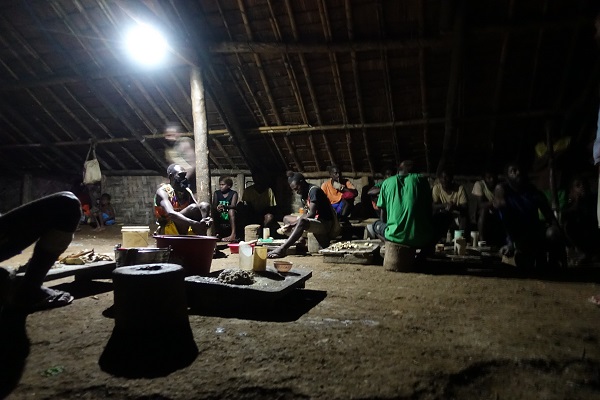
Village nakamal at Lonfis, Pentecost Island. All images courtesy of Chris Kilham unless otherwise noted
In February 2020, I traveled to Vanuatu in
the South Pacific to gain a better understanding of the kava (Piper
methysticum, Piperaceae) trade in that country at this time. Kava, a
medicinal plant prized for its sedative, anxiolytic, and anti-stress effects, is
a major commercial crop in Vanuatu, serving both a consistent domestic market
and a vigorous export trade. I have a long history of kava work in Vanuatu, dating
back to 1995, and played a role in the formation of the international kava
trade at that time. I have traveled to Vanuatu 15 times and was the country’s
Honorary Consul to the United States from 1997 to 2000. In that capacity, I
focused on trade, specifically educational and promotional efforts related to Vanuatu
kava and tamanu oil (Calophyllum inophyllum, Callophyllaceae). My most concentrated years of activity in
Vanuatu were between 1995 and 2005. During that time, I worked with kava on
behalf of Pure World Botanicals (later purchased by Naturex and now part of
Givaudan) and in close alliance with a Vanuatu-based Tahitian named Ariipaea
Salmon. I chronicled some of that period in my book Kava: Medicine Hunting
in Paradise (Park Street Press, 1996). My last trip to Vanuatu before this
one was in April 2012.
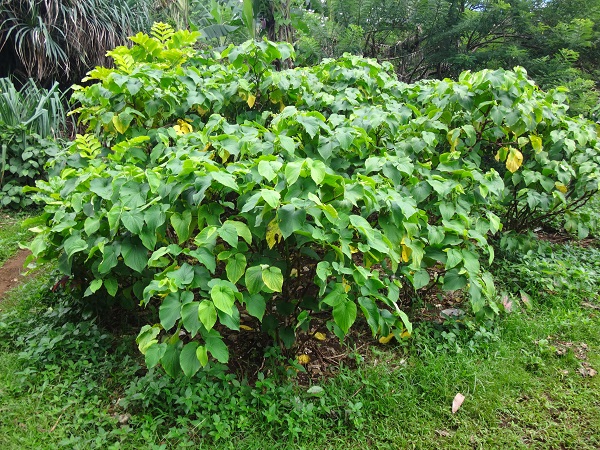
Borogu kava on Pentecost Island
On projects investigating medicinal plants, I
invariably work with traders, as they have the best and broadest connections to
growers, government officials, shippers, and various promotional and other
programs associated with plants. From previous visits to Vanuatu, I knew some
of the 24 registered kava exporters operating in Vanuatu today. Among them, 14 traders
operate out of the capital of Port Vila, seven out of Espiritu Santo, and one
on the isle of Pentecost. Three of the best-known kava exporters among the
Vanuatu business community are Frank King, John Fordham, and Michael Louzé.
For this trip, I reached out to Michael Louzé,
who runs his own kava trading business, South Seas Commodities, in Port Vila.
Michael and I had met on three previous occasions: Once at the home of a mutual
friend, once when he was working with trader Peter Colmar, and once on
Pentecost, which lies to the north of the capital island Éfaté.
Michael is chairman of the Vanuatu Kava Industry
Association. He has operated South Seas Commodities since 2010 and had worked
in the trade for seven years before that. South Seas Commodities operates a sanitary
warehouse near the airport outside of Port Vila on Éfaté, convenient to government
inspection and air shipping facilites. Much of the information presented here is
based on my conversations with Michael as we moved about in Vanuatu. Michael
also developed the Kava World platform kava-world.com, a nexus for kava
activity in Vanuatu.
South Seas receives noble kava roots (see
sidebar) that are pre-cleaned, peeled, cut, washed, and sun-dried. Solar dryers
on Pentecost island, many of them supplied by South Seas, have made a critical
difference in the quality and quantity of the company’s kava supply. On any
given week, South Seas will receive 10-20 bags of dry kava weighing
approximately 25 kilograms (55 pounds) apiece. Once the kava arrives at South
Seas, it undergoes a thorough inspection and pressure washing with filtered
water and more sun-drying. Small pieces of stem, any rootstock pieces with dark
centers, or other suspicious pieces are rejected. Michael estimates that he
loses about 15% of value for the kava he buys from the time agents purchase
kava on Pentecost to the time he exports clean roots and root chips, and has
built this loss into his profit margins.
|
Noble Kava
Noble kava varieties are preferred drinking
kavas for their rapid onset of effect, pleasant promotion of tranquility,
hours of relaxation, and absence of nausea or headache. Noble varieties also
conform to certain relative values of kavalactones, the active relaxing
constituents in kava root. Eighteen kavalactones have been identified in
kava. The primary six kavalactones are kavain, dihydrokavain, methysticin, dihydromethysticin,
yangonin, and demethoxy-yangonin, comprising about 95% of the kavalactone
value. Noble varieties are highest in kavain and dihydrokavain, and low in
demethoxy-yangonin.1 This combination produces the pleasant effect
for which noble kava is known.
|
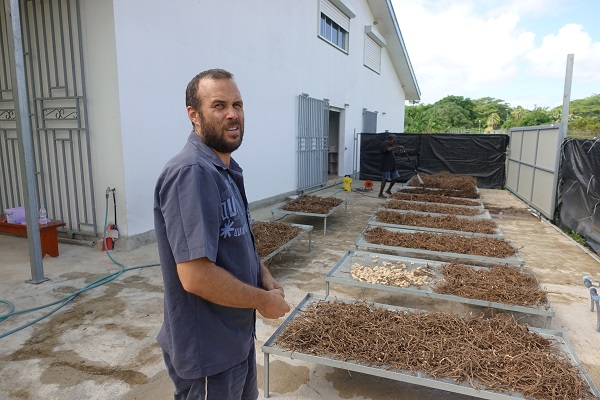
Michael Louzé at South Seas, Ltd.
At the time of my trip in February 2020, Vanuatu
was going through about 40 tons of kava per week in its nakamals (kava
bars), according to Michael. About 90% of all kava produced in Vanuatu goes
directly to nakamals, dwarfing export sales. Still, the kava export trade is
significant and valuable to the Vanuatu economy and culture. Vanuatu had a GDP
of USD $914 million in 2018, according to government figures.2 In
2019, Vanuatu exported a total of 819 tons of kava, generating revenues of 834
million Vatu, or just more than US$7 million. According to tallies from the
Vanuatu Kava Industry Association, the average freight-on-board (FOB) export
price from Port Vila for noble kava root (cut, cleaned, dried, and sorted) currently
is around $40 per kilogram. The largest quantities of kava for export go to
Nouméa, New Caledonia, and Suva, Fiji. In both places, Vanuatu kava fuels a
large and popular kava bar market.3
With high demand and a brisk trade, growers finally
have achieved prices that make them a good profit. At $20-$25 per kg dry weight
of noble, washed, peeled, and sun-dried kava, the Ni-Vanuatu (the indigenous
population of Vanuatu) are buying boats and improving their living conditions. The
substantial price for growers is what my friends and I had hoped for in 1995
when we first helped start the kava trade. The people are doing well and supporting
their families and communities. Manufacturers of kava extract that formerly applied
intense downward pressure on kava prices now have less sway and must pay a fair
price or do without Vanuatu kava.
Many things have changed in Port Vila, the
bustling heart of Éfaté. Traffic is now heavily congested through the center of
town. Cars, trucks, hire buses, and taxis cram the area, creating much exhaust.
The central open market in Vila is more crowded, and numerous new resorts and
hotels in and around town have been built.
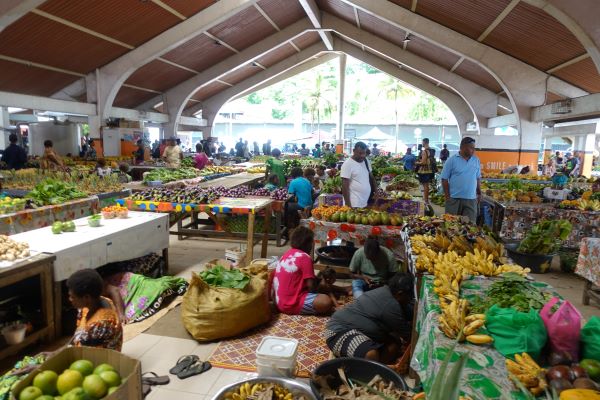
Central market, Port Vila
In relation to kava, a few notable changes
have occurred since my last trip to Vanuatu. These include the opening of the
Anabru kava market, the introduction of kava bars with multiple windows, the
selling of kava and beer together, the elimination of the Vanuatu Commodities
Marketing Board (VCMB), and the abolition of tudei kava exports.
On the outskirts of Port Vila, people from
many islands rent small spaces at the Anabru Market, where they sell their own kava.
Anabru looks like a rustic little motel, one long building with multiple small
rooms. Vendors with both large and small amounts of kava can sell at Anabru. Some
vendors sell two or three sacks’ worth of kava, while others sell entire
truckloads. Many of the smaller local kava bars around Port Vila get their kava
at Anabru market, choosing from kava varieties from Espiritu Santo, Malekula,
Pentecost, and Epi islands. Michael and I visited Anabru market a couple times.
Overall, the kava appeared of low quality, poorly cleaned and unpeeled or
inadequately peeled. But the prices were low, averaging around 700 Vatu per kg,
or $6. Buyers bring kava from Anabru back to their nakamals, wash and peel it,
and give it a final washing to make a good drinking kava that tastes clean and
fresh.
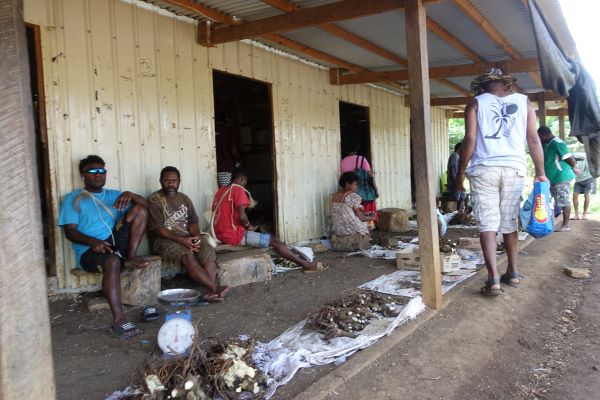
Anabru market
Kava bars with multiple windows were a new
feature to me. I used to go to the kava bar Ronnie’s in the sector 2 district in
Éfaté, a popular and reliable place. But now, instead of one window with one
type of kava, Ronnie’s has at least three windows with preparations from
different kava varieties and makers. At one window, Melomelo kava from Ambae Island
may be offered, and at another, Borogu kava from Pentecost. Just as people
prefer different brands and types of beer, so kava drinkers may prefer one
variety of kava over another.

A local kava bar
At the various kava bars we visited during my
time in Vanuatu, coconut shells have been replaced by ceramic bowls. It used to
be that a small coconut shell filled with kava would cost 50 Vatu, and a large
shell would cost 100 Vatu. Now, the amount of kava that gets ladled into a bowl
determines the cost. Customers may buy a small 50-Vatu bowl, a regular 100-Vatu
bowl, or even a 200-Vatu bowl for a strong bit of kava at once.
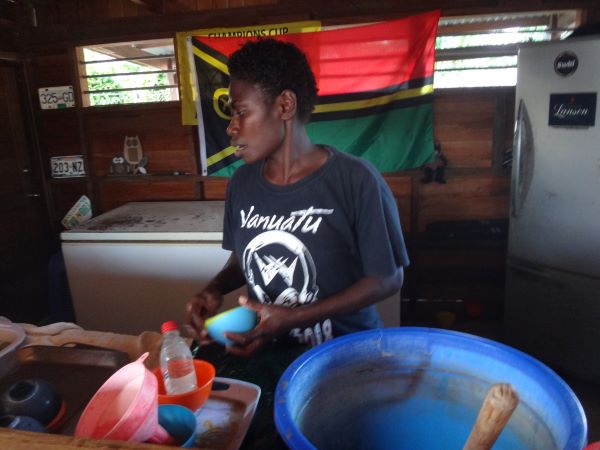
Serving kava
An innovation, if one can call it that, is
the now common sales of both kava and beer at nakamals. It is typical to enjoy
one or two bowls of kava and follow that with a beer. The practice is called kalé
and seems to be particularly enjoyed by tourists and expats.
Another major change in the Vanuatu kava
trade concerns the VCMB, which for decades was the controlling authority for
the kava trade. Since June 2019 the VCMB, which was made up of government
bureaucrats, has been replaced by the more nimble Vanuatu Kava Industry Association,
members of which all work in the kava trade and better understand its
operations, nuances, and needs.
Lastly, the government ban on exports of
tudei or “two-day” kava has boosted overall quality of Vanuatu kava exports.
Two-day kava is especially high in dihydromethysticin and dihydrokavain,
producing a powerful soporific effect and often causing headache or dizziness. It
is called tudei kava because its effects can persist for two days. Previously, many
growers added tudei kava to their bags, and kava bars added tudei to their kava
to produce a stronger experience, but with some potentially unpleasant effects.
I have encountered tudei kava at some kava bars and have not enjoyed the effects
at all. Tudei kava can be identified by testing kava root for flavokavains,
which are not found in noble varieties of kava. The elimination of tudei kava
from all exports ensures a better-quality kava with a better experience.
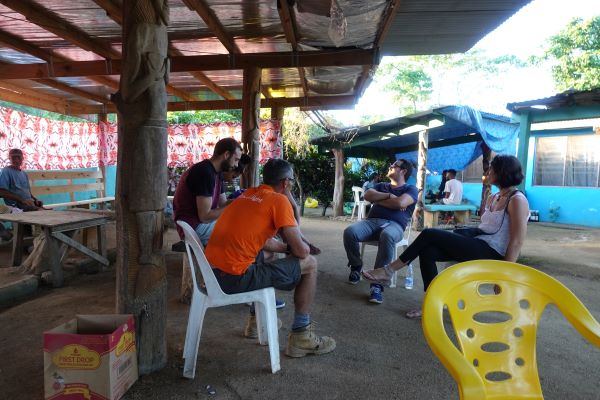
Kava time
Pentecost Island
Much of my history in Vanuatu since 1995 has involved
kava growers in several villages on the island of Pentecost, a long and narrow
island north of Éfaté that is known for its traditional kava culture and high-quality
kava, most notably Borogu, which is a preferred variety for cultivation on that
island. Thus, it was fortuitous that Michael Louzé acquires his kava from
Central and Northern Pentecost, presenting an opportunity to get back to that area.
Michael has four agents on Pentecost, one of
whom is Kasi Bebe on the east coast. I was eager to walk through the entire
chain of trade for the kava that Michael acquires on Pentecost. To do that, we
planned a trip to the island to meet with his agent Kasi and a team with whom
we traveled.
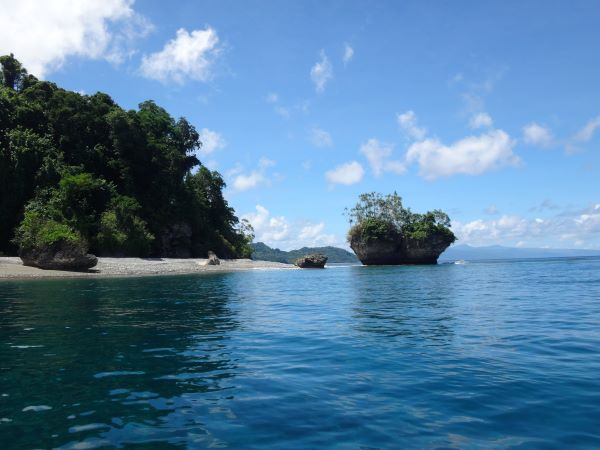
Pentecost Island coast
We flew from Éfaté to the landing strip at
Lonorore on the western coast of Pentecost Island. Lonorore is situated on a
relatively calm and tranquil spot and has undergone significant improvements. The
former bumpy grass strip is now a smooth asphalt runway, offering a nicer
landing. We were met at Lonorore by Kasi, his sons Alexi and Bernard, a young
man named Edmund, and another young man whose name I do not know. They were our
companions and crew wherever we traveled on Pentecost.
During our days on Pentecost, we visited the
Eastern Pentecost villages of St. Henri, Laluk, and Lonfis. Laluk, the furthest
north of the three villages, provides most of the kava sold by South Seas. Some
kava is purchased and inspected at Lonfis, the village where Kasi and his
family live. Some kava from central Pentecost gets stored in a clean kava
storage building that Kasi maintains in St. Henri until it is eventually loaded
onto one of the inter-island boats that ply the seas in that area. Inter-island
traffic delivers goods such as rice, canned foods, beer, and hardware, and
transports crops from outer islands to the capital.
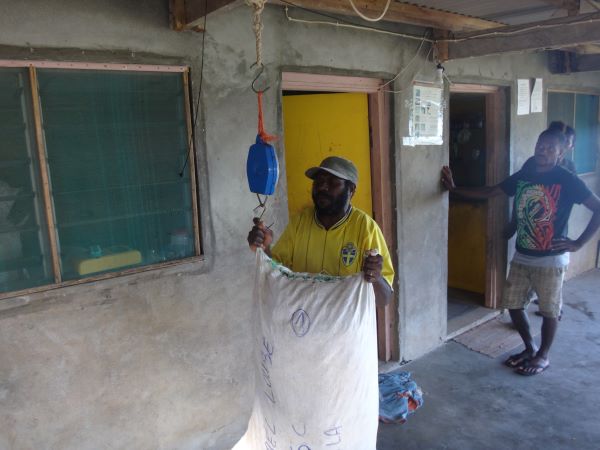
Weighing kava at St. Henri
All transport of kava around the eastern side
of Pentecost is via boats, as no roads are on that side of the island. It is
possible to walk from one village to another throughout the island on well-worn
footpaths. Otherwise, any transport of cargo happens in fiberglass boats and
larger inter-island vessels. Seas range from somewhat disagreeable to violent there,
so hauling kava by boat involves hard work and danger. Yet, except during
storms, kava traders are out in those waters.
At St. Henri, Lonfis, and Laluk, Michael and
I spoke with chiefs and other people from the villages about the state of the
kava trade and our hopes for the future. In each village, we drank kava in a traditional
bamboo and palm nakamal where only men drink, unlike at the kava bars in Port
Vila, where men and women drink together. The native people with whom we spent
time very much want to see kava rise to greater market prominence. They are
especially encouraged that many kava bars in the United States import Vanuatu
kava. That is a source of great pride for the growers.
In Laluk, we started out in fields of Borogu
kava, harvested root, and took it to a nearby stream for washing, peeling, and
chopping. That area of Pentecost enjoys a strong supply of free-flowing spring
water that bursts out of hillsides and forms streams. After washing kava in clean
spring water, the root is cut and dried in solar dryers.
Here are the steps kava undergoes when it is
ready to harvest:
Digging out roots – Vanuatu growers used to wait until kava plants had
matured for five years before harvesting the roots. However, analysis of kava
roots shows that the kavalactone concentration in kava is optimal at three
years’ growth. Thus, many kava growers now harvest roots at three years. All
digging of roots is performed with simple implements, like long poles of wood.
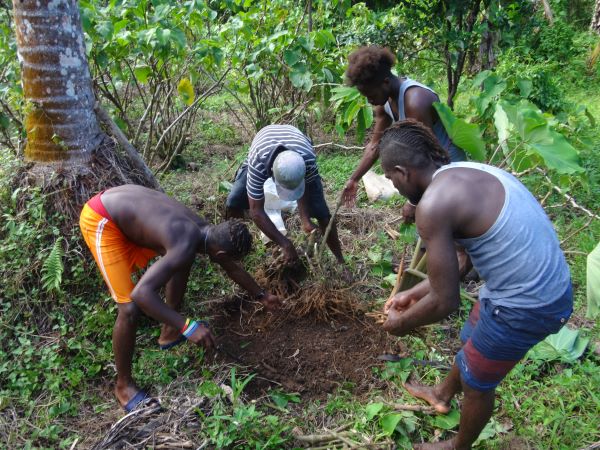
Harvesting a kava root
Cleaning roots – With its ample supply of fresh, clean water, central
eastern Pentecost provides excellent conditions for cleaning kava roots. Here
in a fresh stream, kava root is cleaned of all dirt before peeling the skin.
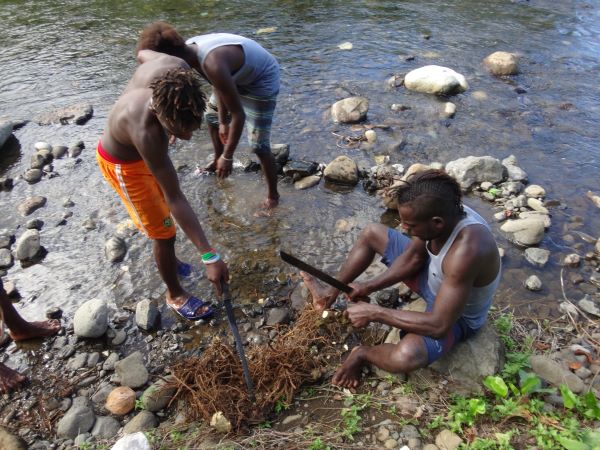
Cleaning kava roots in a stream
Root peeling – Peeling roots is typically performed with a machete.
The Ni-Vanuatu learn to use bush knives from the time they are children. Their
dexterous ability with blades aids them in quickly peeling the tough, fibrous
roots of kava.

Peeling roots
Chopping roots to drying size – After cleaning and peeling, roots are cut to a
preferred size for drying. Every kava grower knows the ideal size to chop roots
— not too thick or thin.
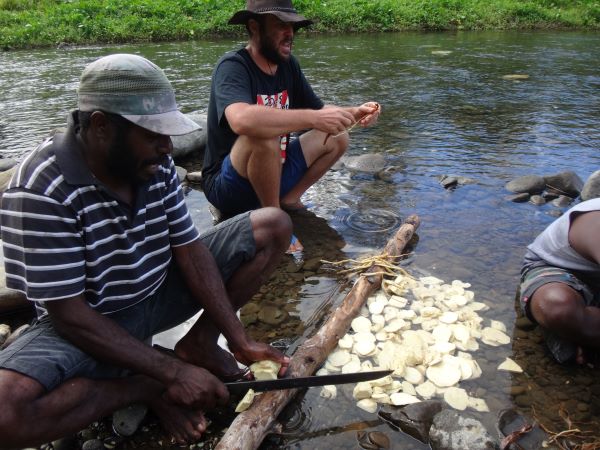
Chopping roots
Drying roots – After cleaning, peeling, and chopping, kava roots are
laid out in solar dryers, where they will dry to about 12% moisture. Solar
dryers make it possible to dry large quantities of kava and protect it from
regular rains.
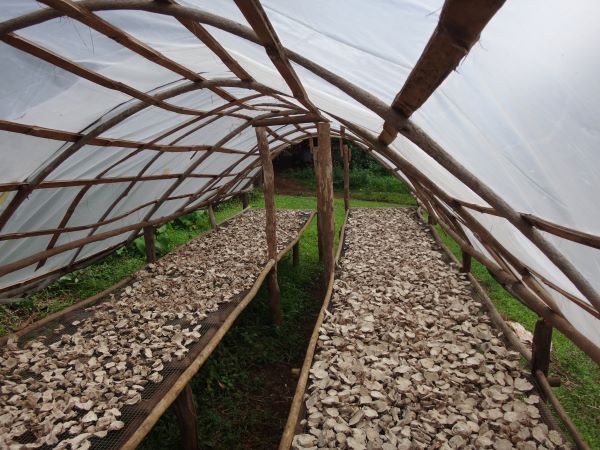
Kava in a solar dryer
Pentecost Island Kava Trade
In the village of Lonfis, where Kasi and his
family live, we saw kava arrive from growers in that area and in nearby
villages. All the kava arrived clean, peeled, washed, and sun-dried. The kava
was then weighed, and the growers were paid cash on the spot. This type of
simple and immediate transaction is typical in the botanical trade worldwide. Even
so, all the kava was then hand inspected, winnowing out any bad pieces. That
kava would be stored until eventual shipment to Port Vila via inter-island
cargo ships and undergo additional inspection, pressure washing, and sun-drying.
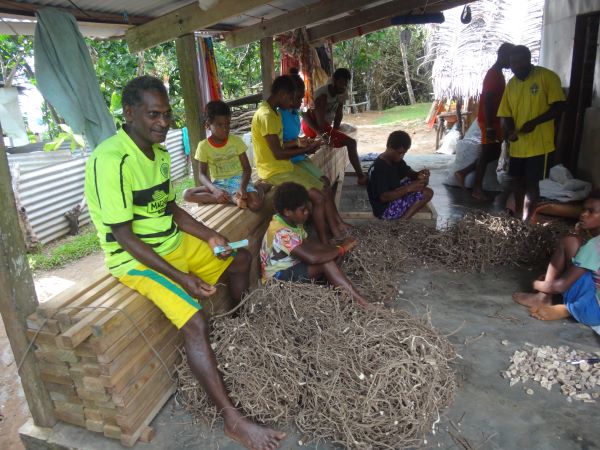
Kava trade in Lonfis
Back in Port Vila, when kava is ready to ship
internationally, an inspector from Quarantine (Vanuatu Biosecurity) examines
the kava for mold, fungus, rot, soil, and other unwanted material. Then, a
sample is taken for testing for adulteration and pathogens at Vanuatu
Biosecurity. Once a sample is approved, the shipper receives the documents
required for export.
Vanuatu kava exporters use Virgin, Air New Zealand,
Air Caledonia, and Air Vanuatu for shipping. Exporters no longer use independent
shippers. Instead, they are making those arrangements themselves. This has
changed since I started there in the 1990s. Half and whole containers of kava,
weighing 10-20 metric tons, are shipped by sea instead.
In Port Vila, I met three scientists who help
ensure the quality of Vanuatu kava: Vincent Lebot, PhD, who remains the most
prominent kava researcher alive; Ruth Amos, who runs government kava testing;
and Sylvie Boulekouran, who heads up the Quarantine kava program. All three described
to me their ongoing efforts to enhance testing of kava to maintain high-quality
kava exports. Vincent is working with simple colorimetric tests to help assess
types of kava, as well as high-performance thin-layer chromatography (HPTLC).
Ruth is working on a possible expanded bacterial testing initiative. Sylvie is
making sure that all kava samples undergo necessary scrutiny before receiving
papers for export.
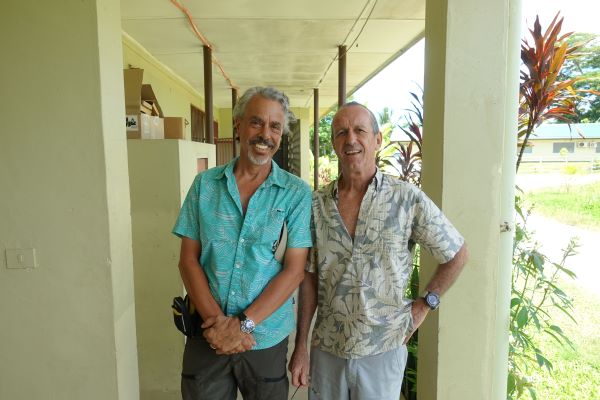
Chris Kilham and Vincent Lebot
Calamity in Paradise
Days after I departed Vanuatu in February, COVID-19
so gripped the world that all shipping to and from Vanuatu ceased. All air
traffic in and out of the country was halted, and regular passenger cruise
ships stopped. The cessation of ingoing and outgoing traffic and tourists
closed restaurants, hotels, resorts, and spas in Vanuatu, reduced traffic in
kava bars, shuttered businesses, and halted kava exports. Only in May did some
exports resume to New Caledonia. And while no cases of COVID-19 have been reported
in Vanuatu as of June 15, the economic damage of the pandemic has been acute
for the tourism-dependent archipelago. That damage has reverberated throughout
the entire kava chain of trade, slowing demand and reducing revenues.
At the beginning of April 2020, piling misery
on top of COVID-19, Cyclone Harold, a Category 5 tropical cyclone hit Vanuatu,
the Solomon Islands, Fiji, and Tonga, devastating many villages and destroying
hundreds of thousands of kava plants. The villages Michael and I visited on
Pentecost Island were hit badly, with homes and solar dryers destroyed. Growers
have subsequently worked feverishly to get as much damaged kava out of the
ground, cleaned and dried, to rescue some crop and income.
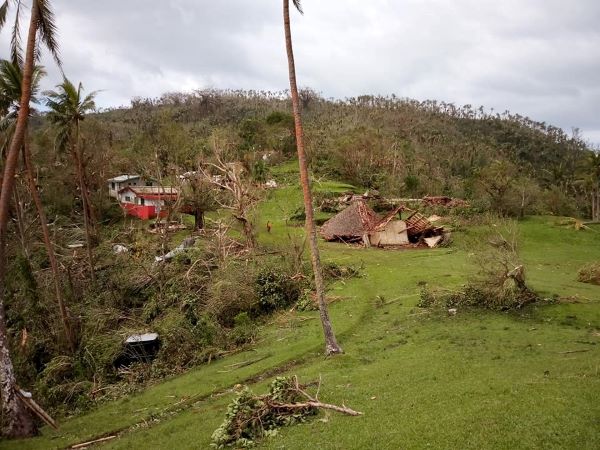
Damage from Cyclone Harold. Photo courtesy of Michael
Louzé
At present, the government of Vanuatu is allowing only the
islands that were affected by Cyclone Harold to sell kava to Port Vila. The
Minister of Climate Change, Bruno Leingkone, has assured all the people of
Pentecost and other affected islands that they can put their kava on any cargo ships
to be dropped at Port Vila without charge.
From Michael Louzé (June 19,
2020):
The market is strange but going strong in a way.
Before the cyclone, most exporters had big stock and had slowed down their
purchases or stopped completely. After the cyclone, many believed that kava
production will face a new shortage for the next three years (including myself
to a certain extent), and many traders and exporters start to speculate.
Farmers of course entertained this by saying it was their last harvest, and
that after this, in one-month time there would be no kava for a long time.
The weather has been very good and sunny, ideal for
sun drying, so with buyers willing to buy everything they could, farmers are
selling as much as they can! Between you and me, I don’t believe now that we
will have a shortage. Many kava farms are untouched, lots of islands were not
affected, and Pentecost was blessed by its many hills protecting many gardens.
[The] market in New Caledonia has resumed, slightly
slower and tighter than before but still going strong ... but it is getting
submerged with kava and should slow down in the weeks to come.
The USA, with the lockdown and logistics issues,
had not been able to get kava for their nakamals so stocks were very low, and
they are now ordering a lot ... the complete effect of [COVID-19] on the kava
bar sector in the USA remains to be seen … with huge unemployment, etc., many
households probably lessen their spending … and kava was a quite expensive
habit.... We will see....
Conclusion
Vanuatu
has a sustainable kava trade in which the plant is cultivated without any toxic
agricultural inputs, the growers get a fair price, and market demand remains
strong. The entire Vanuatu kava industry has become more sophisticated, with
more measures to ensure high quality of exports and avoid contamination.
Both COVID-19
and Cyclone Harold have badly affected the Vanuatu kava trade, but this is a
temporary situation. Kava from parts of Vanuatu that were not badly hit by
Harold will fill a market void, and eventual lifting of shipping restrictions
will allow for more export trade. Recovery will take time. Yet the people of
Vanuatu remain remarkably resilient, and demand remains strong for kava, a
stress-relieving agent that promotes peace and tranquility.
References
- Fu PP, Xia Q, Guo L, Yu H, Chan PC. Toxicity
of kava kava. J Environ Sci Health C Environ Carcinog Ecotoxicol Rev.
2008;26(1):89-112. Available at: www.ncbi.nlm.nih.gov/pmc/articles/PMC5868963/. Accessed June 25, 2020.
- GDP
(current US$) – Vanuatu. The World Bank website. Available at: https://data.worldbank.org/indicator/NY.GDP.MKTP.CD?locations=VU.
Accessed June 25, 2020.
- Pollock
NJ. Sustainability of the kava trade. The Contemporary Pacific.
2009;21(2):265-297. Available at: https://scholarspace.manoa.hawaii.edu/bitstream/10125/18514/v21n2-265-297.pdf.
Accessed June 25, 2020.
|